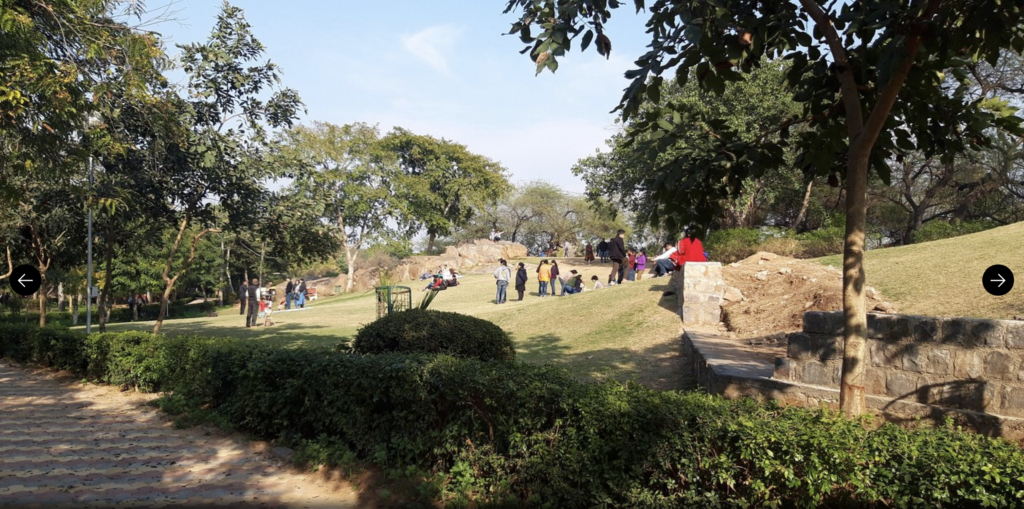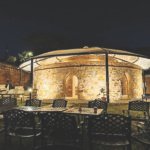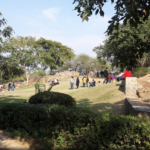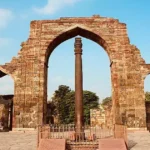Mehrauli Archaeological Park is a historic site in Delhi, India, that spans over 200 acres and contains over 100 historically significant monuments. The park is located in the Mehrauli neighborhood of the South Delhi district and is adjacent to the Qutub Minar, a UNESCO World Heritage Site.
The Mehrauli Archaeological Park is the only area in Delhi known to have been continuously occupied for 1,000 years, and it displays the rich heritage of India from the Pre-Islamic to the Colonial phase.
The park contains a variety of ancient ruins, monuments, and temples dating back to the 11th century. The Lal Kot, a fort built by Anang Pal in the 11th century, is one of the most significant structures in the park.
The Dadabari Jain Mandir, a temple dedicated to a Jain saint, Hauz-e-Shamsi, a water reservoir and mosque complex, and Jahaz Mahal, a palace with a mihrab, are other notable structures within the park. Visitors can explore the park on foot and take in the breathtaking architecture and history of the area.
Mehrauli Archaeological Park is a must-visit destination for anyone interested in history and architecture. The park offers a glimpse into a bygone era and showcases the rich cultural heritage of India. Visitors can spend hours exploring the park and taking in the beauty and history of the structures within.
History
Mehrauli Archaeological Park is a site of great historical significance, located in Delhi, India. The park spans over 100 acres of land and houses over 100 historically significant monuments. The site showcases the rich heritage of India, starting from the Pre-Islamic period to the Colonial phase.
Early Settlements
The history of Mehrauli Archaeological Park dates back to the 11th century when it was known as Lal Kot. The Tomar Rajputs built Lal Kot in 1060 CE, making it the oldest extant fort in Delhi. Lal Kot was later expanded by the Chauhan Rajputs, who renamed it Qila Rai Pithora.
Delhi Sultanate Era
During the Delhi Sultanate era, Mehrauli became the first of the seven cities of Delhi. The Sultanate period saw the construction of several significant monuments, including the Qutub Minar, the Alai Darwaza, and the Adham Khan Tomb.
Mughal Period
The Mughal period saw the construction of several significant structures, including the Jahaz Mahal, Zafar Mahal, and the Hauz-i-Shamsi. The Mughals also constructed several gardens and water bodies, including the Tomb of Balban and the Tomb of Quli Khan.
British Colonial Period
The British colonial period saw the construction of several structures, including the Metcalfe House and the Jamali Kamali Mosque. The British also built several roads and bridges in the area, including the Mehrauli-Badarpur Road and the Qutub Minar Bridge.
Post-Independence
After India gained independence in 1947, the Archaeological Survey of India took over the management of Mehrauli Archaeological Park. The site was declared a protected monument in 1951 and has since been a popular tourist destination.
In conclusion, Mehrauli Archaeological Park is a testament to India’s rich cultural heritage and a must-visit destination for history enthusiasts.
Geography
Location
Mehrauli Archaeological Park is located in the South Delhi district of Delhi, India, adjacent to the Qutub Minar (a World Heritage Site) and the Qutb complex. The park is spread over an area of more than 200 acres (80 ha). It is bound by the Chattarpur Road to the east and the Qutb Complex in the north.
Landscape Features
The park covers 100 acres of green land and is dotted with remains from every era of Delhi’s history—from the pre-Islamic to the late Mughal and the colonial period.
The Tomar Rajputs established Lal Kot, the first fortification in Delhi here. The succeeding Chauhan rulers extended Lal Kot to form Qila Rai Pithora.
The park consists of over 100 historically significant monuments, including the remains of the first city of Delhi, the capital of the Tomar rulers in the 11th century.
The park is home to several water bodies, including a large lake, which adds to the beauty of the landscape. The park is also home to several species of birds and animals, making it a popular spot for nature lovers and bird watchers. The park’s greenery and serene atmosphere make it a perfect place for picnics and family outings.
In conclusion, Mehrauli Archaeological Park is a unique place that showcases the rich heritage of India. Its location and landscape features make it a must-visit destination for tourists and locals alike.
Main Attractions in Mehrauli:
Mehrauli Archaeological Park is a treasure trove of history and culture. With over 440 monuments, it is a must-visit destination for history buffs and architecture enthusiasts. Here are some of the main attractions of the park:
Qutb Minar

The Qutb Minar, a UNESCO World Heritage Site, is a towering 73-meter-high minaret made of red sandstone and marble. It was built in the early 13th century by Qutb-ud-din Aibak, the first ruler of the Delhi Sultanate. The minar is surrounded by several other ancient structures, including the Quwwat-ul-Islam Mosque, which is considered one of the oldest mosques in India.
Jamali Kamali Mosque and Tomb
The Jamali Kamali Mosque and Tomb is a beautiful example of Mughal architecture. It was built in the 16th century and is named after two individuals buried there: Jamali, a Sufi saint, and Kamali, who is believed to be his disciple. The mosque is adorned with intricate carvings and calligraphy, and the tomb features a beautiful dome.
Balban’s Tomb
Balban’s Tomb is a magnificent structure that was built in the 13th century. It is considered to be one of the earliest examples of a true arch and dome in India. The tomb is located on a raised platform and features intricate carvings and inscriptions.
Rajon Ki Baoli
Rajon Ki Baoli is a stepwell that was built in the 16th century. It is a beautiful example of ancient Indian engineering and architecture. The stepwell has a symmetrical design and features several levels of steps that lead down to a rectangular-shaped well. It is believed that the stepwell was used to harvest rainwater and provide water for the nearby village.
Overall, Mehrauli Archaeological Park is a fascinating destination that offers a glimpse into India’s rich history and culture. Visitors can spend hours exploring the various monuments and structures, and learning about the country’s ancient past.
Conservation Efforts
Mehrauli Archaeological Park is an important cultural heritage site in Delhi, India. Over the years, the Archaeological Survey of India (ASI) has been actively involved in preserving and restoring the park’s structures and monuments.
The following subsections provide an overview of the conservation efforts undertaken by ASI.
Archaeological Survey of India
The ASI is responsible for the conservation, preservation, and management of the country’s cultural heritage sites.
In the context of Mehrauli Archaeological Park, the ASI has been instrumental in identifying the various structures and monuments that require restoration and conservation.
The ASI has also been involved in developing a comprehensive conservation management plan for the park, which includes the park’s division into four zones with proposed activities such as a rose garden, heritage trails, historic orchards, and Charbagh.
The plan has been approved by the 380th Screening Committee Meeting.
Restoration Projects
The ASI has undertaken several restoration projects in Mehrauli Archaeological Park to preserve the park’s structures and monuments for future generations. For instance, the ASI has restored and conserved the Balban’s Tomb complex, which was once completely covered with weeds.
The ASI has also restored the 13th-century tomb of Ghiyas-ud-din Balban, located inside the park, which is believed to be the first monument built in the Indo-Islamic architectural style. Major restoration and conservation works have also been done at Mehrauli Archaeological Park so that Delhi residents have a place to explore the Capital’s rich history and enjoy their time.
In conclusion, the ASI’s conservation efforts have helped in preserving the cultural heritage of Mehrauli Archaeological Park. The restoration projects undertaken by the ASI have helped in the preservation of the park’s structures and monuments, which are of historical and cultural significance.
Visitor Information
Opening Hours
Mehrauli Archaeological Park is open from sunrise to sunset, seven days a week. Visitors are advised to check the timings before planning their visit to avoid any inconvenience.
Hours:
| Saturday | 5 am–6:30 pm |
| Sunday | 5 am–6:30 pm |
| Monday | 5 am–6:30 pm |
| Tuesday | 5 am–6:30 pm |
| Wednesday | 5 am–6:30 pm |
| Thursday | 5 am–6:30 pm |
| Friday | 5 am–6:30 pm |
Entry Fee
There is no entry fee to visit the park. Visitors can enjoy the historical monuments and the lush greenery without any charge.
Guided Tours
Guided tours are available for visitors who want to learn more about the history and significance of the monuments. Visitors can hire a guide at the entrance of the park for a nominal fee. The guides are knowledgeable and provide interesting insights into the history of the park and its monuments.
Facilities
The park has basic facilities such as restrooms, drinking water, and seating areas. Visitors are advised to carry their own water bottles and snacks as there are no food vendors inside the park. The park is wheelchair accessible, but some areas may be difficult to navigate due to uneven terrain.
Overall, Mehrauli Archaeological Park is a must-visit destination for history buffs and nature lovers alike. Visitors can spend hours exploring the park and its monuments, and enjoy a peaceful break from the hustle and bustle of the city.
Cultural Significance
Mehrauli Archaeological Park is a significant cultural heritage site in India. It has a rich history that dates back to the 11th century, and it is home to over 100 historically significant monuments. The park is spread over 200 acres, and it is located in the Mehrauli neighborhood of South Delhi, adjacent to the Qutub Minar.
Architectural Heritage
The park is home to several historically significant monuments, including the ruins of the first city of Delhi, the capital of the Tomar rulers in the 11th century. The park also includes the ruins of Lal Kot, built by Tomar Rajputs in 1060 CE, making it the oldest extant fort of Delhi. Visitors can also see architectural relics from the subsequent periods of the Khalji dynasty, Tughlaq dynasty, Lodhi dynasty of Delhi Sultanate, Mughal Empire, and the British Raj.
The architectural heritage of the park is a testament to the rich cultural history of India. The park’s monuments showcase the country’s diverse architectural styles, from the Hindu and Islamic styles of the medieval period to the British colonial architecture of the 19th and 20th centuries.
Educational Importance
The Mehrauli Archaeological Park is not only a significant cultural heritage site but also an important educational resource. The park provides visitors with an opportunity to learn about India’s rich history and cultural heritage. The park is also a valuable resource for archaeologists, historians, and researchers who are interested in studying India’s past.
The park’s educational importance is further enhanced by the fact that it is the only area in Delhi known for 1,000 years of continuous occupation. The park’s monuments have survived through centuries of occupation, and they provide a unique insight into the country’s past.
In conclusion, the Mehrauli Archaeological Park is a significant cultural heritage site in India. Its architectural heritage and educational importance make it a valuable resource for visitors, researchers, and historians alike.
Frequently Asked Questions
How can I book tickets online for Mehrauli Archaeological Park?
Visitors can book tickets online for Mehrauli Archaeological Park through the official website of the Archaeological Survey of India (ASI). The website offers an easy and convenient way to book tickets in advance, avoiding long queues at the park entrance. Visitors can also purchase tickets on-site at the ticket counter.
What is the entry fee for Mehrauli Archaeological Park?
The entry fee for Mehrauli Archaeological Park is INR 35 for Indian nationals and INR 500 for foreign nationals. Children under the age of 15 can enter for free. Visitors can also purchase a composite ticket for INR 100, which includes entry to several other monuments in Delhi, including the Qutub Minar.
Can you provide a brief history of Mehrauli Archaeological Park?
Mehrauli Archaeological Park is an archaeological area spread over 200 acres in the Mehrauli neighborhood of the South Delhi district of Delhi, India. The park is adjacent to the Qutub Minar, a UNESCO World Heritage Site, and the Qutb complex. It consists of over 100 historically significant monuments, including tombs, mosques, and step wells, dating back to the 13th century. The park is a testament to the rich cultural heritage of India and is a popular tourist destination.
Are there dining options available within Mehrauli Archaeological Park?
There are no dining options available within Mehrauli Archaeological Park. However, visitors can find several restaurants and cafes in the nearby area, offering a variety of cuisines.
What are the transportation options to reach Mehrauli Archaeological Park?
Visitors can reach Mehrauli Archaeological Park by hiring a taxi or an auto-rickshaw. The park is also accessible by Delhi Metro, with the nearest metro station being Qutub Minar on the Yellow Line. From the metro station, visitors can take a short walk or hire a cycle-rickshaw to reach the park.
Does Mehrauli Archaeological Park include the Qutub Minar?
Mehrauli Archaeological Park is adjacent to the Qutub Minar and the Qutb complex, but it does not include the Qutub Minar itself. Visitors can purchase a separate ticket to enter the Qutb complex and explore the Qutub Minar.







